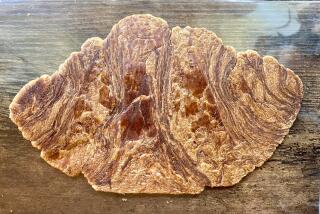Test Kitchen video tip: Homemade meringue 101
Really nothing more than a combination of egg whites and sugar whipped to frothy peaks, meringue is a simple but key player in a variety of baking and pastry recipes.
Use it as a topping, gracing lemon or key lime pies, or maybe spread it over a cake as a classic seven-minute frosting. It can be used as a leavener, added to cake batters (angel food, chiffon and other sponge cakes) to lighten the crumb, give lift to souffles, or used to lighten custard and cream fillings. Bake it as a dessert element (a vacherin or hard meringue container) or use it as the base for macaron cookies. The options are almost endless.
To make the most of your meringue, keep in mind a few basic tips:
- Use room temperature egg whites. Room temperature egg whites will give greater volume than cold whites just out of the refrigerator.
- Whip the whites using a clean bowl and beater. Dirt and oils will prevent the whites from properly foaming as they are beaten.
- Sometimes acids (lemon juice, cream of tartar) are added to the whites. Acids help the whites to foam and make them stable.
- Beat the whites over low speed to strengthen the structure of the bubbles as they form, then slowly “rain” in the sugar with the mixer going, a tablespoon or so at a time. If incorporating cooked sugar, with the mixer running, slowly pour the sugar off to the side away from the beater to keep it from hitting the beater and splashing on the sides of the bowl. (Sugar hitting the sides of the bowl can cool and harden quickly; if this happens, don’t try to incorporate it into the meringue -- it won’t incorporate, and will make the meringue gritty and lumpy.)
- Keep beating (you can slowly increase the speed of the mixer), just until the whites come to the correct volume, whether soft (peaks fall over when beater is lifted), medium (peaks droop slightly) or stiff (shown at top -- peaks stay firm) peaks.
- Be careful not to overbeat the eggs. Check the eggs periodically as they thicken; if the eggs overbeat (they will look crumbly), their delicate structure will break down. The meringue should look smooth, shiny and moist; overbeaten meringues cannot be fixed.
Want more? Check out the recipe for Nick & Stef’s lemon meringue pie recipe below.
Cooking is fun — at least it should be! No matter how long you’ve been in the kitchen, there is always something new to learn, whether it’s a simple twist on an old technique, or a handy tip to save time and energy. In this series of short videos, I demonstrate a variety of kitchen tips, ranging from how to hold a chef’s knife for maximum control to using a spoon to peel fresh ginger. If you have any gadgets, kitchen tips or questions you’d like me to explore, leave a comment or shoot me an email at noelle.carter@latimes.
NICK & STEF’S LEMON MERINGUE PIE
Total time: 1 hour, 25 minutes plus chilling time | Serves 8 to 10
Note: Adapted from a Nick & Stef’s recipe. The dough makes enough for two pies. Half of the dough can be frozen, tightly wrapped, for up to 6 months. Gelatin sheets are available at baking supply stores.
SWEET DOUGH
1 cup (2 sticks) butter
3/4 cup plus 3 tablespoons sugar
1 egg yolk
1 whole egg
1/3 cup almond flour
3 1/4 cup flour
1/2 teaspoon baking powder
1. Cream the butter and sugar together in the bowl of a standing mixer fitted with a paddle attachment until it has a creamy consistency. Alternatively, cream the butter and sugar together in a large bowl using a hand mixer. With the mixer on, add the egg yolk until it is incorporated, then add the egg and incorporate completely.
2. In a separate bowl, sift together the almond flour, flour and baking powder. Add the dry ingredients to the mixing bowl slowly and continue mixing until the dough is thoroughly combined. The dough should be slightly sticky but not wet. If the dough is too dry and crumbly, add up to 1 tablespoon of water to moisten the dough.
3. Divide the dough into two equal portions. Shape each portion into a circle and cover tightly with plastic wrap. Refrigerate one of the portions, and allow it to rest for at least 1 hour. The remaining portion can be frozen for up to 6 months. (For frozen dough, thaw in the refrigerator before using.)
4. Heat the oven to 350 degrees. Remove the chilled dough from the refrigerator, and place on a lightly floured work surface. Roll out the dough into a circle slightly less than one-fourth-inch thick and about 12 inches in diameter. Gently drape the dough into a 9-inch pie pan, and trim off any excess dough so that the crust is flush with the sides of the pan. With a fork, prick holes all over the dough to allow steam to escape during baking. Bake until golden brown, 15 to 25 minutes. Allow to cool on a rack.
LEMON CURD
4 eggs
2 egg yolks
1 cup sugar
Zest of 1 lemon
1 cup fresh lemon juice
2 gelatin sheets
1/2 cup butter (1 stick), cut into 1/2 -inch cubes
1 baked pie shell
1. In a large heat-proof mixing bowl (you should be able to set it over a large pan or stock pot of simmering water to form a bain-marie), whisk together the eggs, egg yolks, sugar and lemon zest. Whisk in the lemon juice.
2. Fill a small bowl with water, and insert the gelatin sheets to allow them to soften. Place the butter cubes into a medium bowl and set aside.
3. Place the bowl with the lemon curd over a larger pot of gently simmering water to form a bain-marie. Cook the curd, stirring gently but constantly, until the curd begins to thicken and will lie on top of itself. Watch carefully to make sure the heat is not so hot that the eggs scramble. Immediately remove the curd from the stove, and pour the curd into the bowl with the butter. Remove the gelatin sheets from the water, wringing out any extra moisture, and add to the curd mixture. Gently stir the curd with a spatula to melt and incorporate the butter and gelatin into the mixture.
4. Pour the lemon curd into the prebaked pie shell. Cover the surface of the curd with plastic wrap, and place in the refrigerator for at least a few hours, preferably overnight, until the curd is set.
LEMON MERINGUE PIE
1 1/4 cup sugar
4 egg whites
1 lemon pie
1. Place the sugar in a medium saucepan. Add one-half cup water, and stir with the sugar until it is the consistency of wet sand. Place the saucepan over medium-high heat, and cook the sugar until a thermometer inserted reads 240 degrees. (The sugar will form a firm ball when a little is dropped into a bowl of cold water).
2. While the sugar is cooking, begin whipping the egg whites. Continue beating until the whites form stiff peaks, but be careful not to over-beat.
3. When the sugar is ready, immediately remove it from the heat, and pour it into a heat-proof measuring cup to stop the cooking process. With the mixer speed on low, carefully begin pouring in the sugar, watching that the sugar does not touch the wire beaters and splatter. Once all of the sugar is added, increase the mixer speed to medium, and continue beating until the meringue cools and is very fluffy.
4. Remove the chilled lemon pie from the refrigerator and remove the plastic wrap. Spoon the meringue on top of the curd with a rubber spatula, forming a dome on top of the pie. To toast the meringue (which is optional), use a small hand torch and lightly torch the meringue until it is golden brown. Serve immediately.
Each serving: 518 calories; 9 grams protein; 73 grams carbohydrates; 1 gram fiber; 22 grams fat; 13 grams saturated fat; 195 mg. cholesterol; 74 mg. sodium.
Love cooking as much as I do? Follow me @noellecarter
More to Read
Eat your way across L.A.
Get our weekly Tasting Notes newsletter for reviews, news and more.
You may occasionally receive promotional content from the Los Angeles Times.







